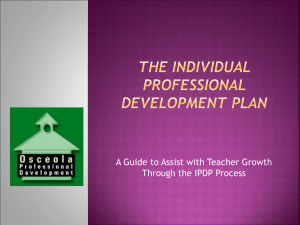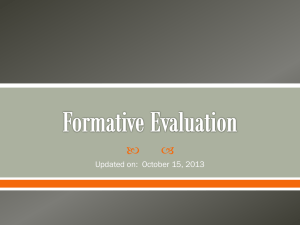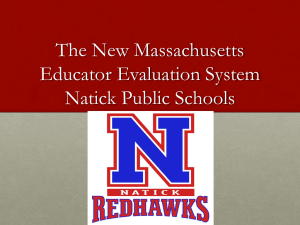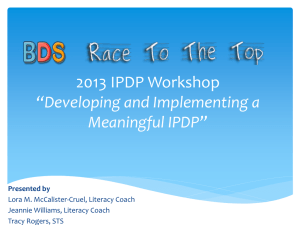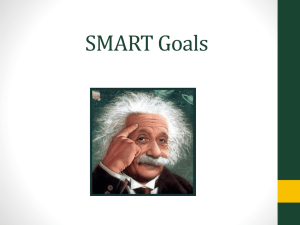professional learning objectives
advertisement
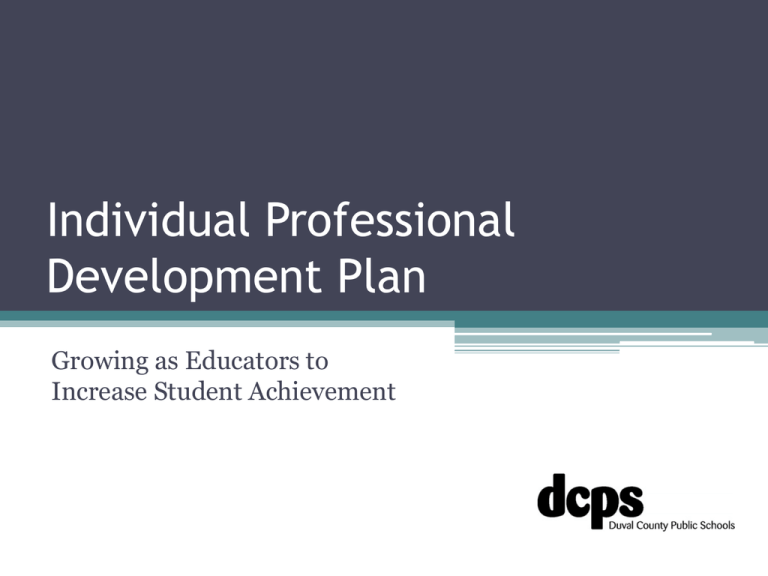
Individual Professional Development Plan Growing as Educators to Increase Student Achievement What is your IPDP? An Individual Professional Development Plan (IPDP) is your plan for how you will grow as a professional during the school year. The IPDP should reflect your professional learning needs related to improving student achievement and enhancing your craft as an educator. DCPS IPDPs FLDOE guidelines require that instructional personnel use the district-approved IPDP template. MINT Participants and school counselors have specific IPDP templates. The IPDP template may not be altered with the exception of inserting rows for additional professional learning objectives as needed. Getting Started Before writing your IPDP consider the following: current classroom-level disaggregated student achievement data your IPDP from last year your evaluation from last year the School Improvement Plan (SIP) school initiatives such as professional learning community (PLC) work Completing the IPDP The Six IPDP Sections Student Achievement Data Student Achievement SMART Goal Educator Professional Learning Goals Professional Learning Objectives Changes in Educator’s Practices Results Student Achievement Data STUDENT ACHIEVEMENT DATA Review classroom-level disaggregated student achievement data for students currently assigned to you. Select your identified student group based on the following: your data analysis, School Improvement Plan, school initiatives, team goals, and the results from your previous year’s IPDP. Both formative and summative data may be included. Behavioral data may also be included. Identified Student Group Within a Class/Section Assessment Type (right click to add rows as needed) Current Score Average Goal Mid-Year Final Score Score Average (as needed) Student Achievement Data Identified Student Group: Based on performance data which indicate improvement is needed, identify a group of students currently assigned to you that will be your focus. Consider groups identified by classroom data, the School Improvement Plan, school initiatives, team goals, and behavioral data related to content area skills. Select one group of students to identify for your IPDP identified student group. Student Achievement Data Examples of Identified Student Groups: Lowest 25% by Content Area Exceptional Student Education (ESE) English Language Learners (ELL) Students with Disabilities (SWD) FCAT/EOC Achievement Levels (example: Level 2 Math) PRS Success Zones in FAIR (example: Low Success, Red) Florida Alternate Assessment Levels Retained Students Subgroups by Ethnicity Gifted Students Students in RtI Tier II Gender Groups Overage Students Students with Attendance Issues Economically Disadvantaged Behavior Groups Student Achievement Data Assessment Type: Formative assessments, such as progress monitoring instruments, FAIR, unit tests, writing prompts, student portfolios or journals, exit slips, quizzes/tests using NGSS and CCSS question stems, or other teacher/district assessments are a few examples. You may also include summative data such as FCAT and EOC exams or behavioral data related to content area skills. Student Achievement Data Include numerical assessment data for the students in your identified group. What is your identified group’s current score average? Where do you anticipate your group will score by the end of the year? This becomes your data goal. During the year, you may want to update the mid-year scores for your identified group so you can revise your IPDP Professional Learning Objectives to meet your learning needs. Student Achievement Data STUDENT ACHIEVEMENT DATA Review classroom-level disaggregated student achievement data for students currently assigned to you. Select your identified student group based on the following: your data analysis, School Improvement Plan, school initiatives, team goals, and the results from your previous year’s IPDP. Both formative and summative data may be included. Behavioral data may also be included. Current Mid-Year Identified Student Group Within a Final Score Assessment Type Score Goal Score Class/Section Average Average (as needed) 2nd Grade CCSS District Math 30% 60% 36% 57% Assessment Tier II Behavior students in my 2nd Individual Teacher-Developed 4 out of 5 0 out of 5 grade homeroom (5 students) Student Behavior Charts students 3 out of 5 4 out of 5 are will be students students successful successful Only one identified student group is required Your IPDP may include formative and summative data Identify a challenging but attainable goal Calculate the current score average for the students in your identified group Calculate the final score average for the students in your identified group Student Achievement SMART Goal STUDENT ACHIEVEMENT SMART GOAL Your Student Achievement SMART Goal (Strategic and Specific, Measurable, Attainable, Results-based, Timebound) must be specific to the student group you have identified and indicate measurable improvements that are expected in student achievement as a result of your professional learning. At least ____% of my _________________ students will score at or above ____% on the _____________________ by ___________. Student Achievement SMART Goal A SMART Goal is… Strategic & Specific: The outcome or end result is clear. Measurable: Numerical evidence that will indicate if the goal has been achieved. Attainable: The goal may be a challenge, but it is possible with available resources. Results-oriented: An identified area. Time-bound: A date by which the goal will be achieved. Student Achievement SMART Goal Examples: At least 75% of my students in the “Lowest 25%” in 5th grade math will score at or above 60% on progress monitoring assessments by March. 80% of my 2nd grade ELL students will demonstrate a probability of reading success (PRS) score of 54% or above on AP3 of FAIR in the spring. Non-examples: A majority of my class will increase their FCAT score. Most of my 9th grade algebra students will pass their EOC exam. Student Achievement SMART Goal STUDENT ACHIEVEMENT SMART GOAL Your Student Achievement SMART Goal (Strategic and Specific, Measurable, Attainable, Results-based, Time-bound) must be specific to the student group you have identified and indicate measurable improvements that are expected in student achievement as a result of your professional learning. At least 60% (3 out of 5) of my Tier II Behavior students in my 2nd grade homeroom will score at or above 60% on the final administration of the 2nd Grade CCSS District Math Assessment in May. Name of the assessment How many of the students in your group can reach the established goal? Name of identified student group and grade level Date or month This is the same percentage goal from the section above Educator Professional Learning Goals Educator Professional Learning Goals Each educator’s goals will vary based on the students assigned to them, their grade level, content area, certification, etc. Your professional learning goals should reflect the professional development you need to be an effective educator. The IPDP focus is on professional learning goals for the current school year. Educator Professional Learning Goals Your professional learning goals should include consideration of the following: learning opportunities needed to help you meet your SMART Goal professional practice needs (ex: OOF, additional certifications) School Improvement Plan (SIP) results of your previous year’s IPDP your evaluation from last year school initiatives administrator recommendations Educator Professional Learning Goals EDUCATOR PROFESSIONAL LEARNING GOALS Your Professional Learning Goals will reflect the individual professional development you need to meet your Student Achievement SMART Goal and other professional practice needs. It will be helpful to reflect on the results of last year’s IPDP as you develop your learning goals for this year. Additional professional learning needs may be identified when you meet with your administrator to review your IPDP. My professional learning goals this year are to effectively implement Tier II RtI behavior strategies and improve my classroom rituals and routines because the students in my classroom with chronic behavior needs are also the lowest performing in math. I want to focus on positive behavior support systems that will help me create a respectful classroom environment that is focused on learning. This narrative section provides a place for you to personalize your IPDP and reflect on the learning you want to achieve during the school year. Professional Learning Objectives PROFESSIONAL LEARNING OBJECTIVES To address my Student Achievement SMART Goal and Professional Learning Goals, I will complete the following specific professional learning: Professional Learning (a minimum of two are required) Implementation Plans Anticipated Date of Completion Actual Date of Completion Professional Learning Objectives What professional learning will you complete? District, school-based, and/or individual Participation in a collaborative professional learning community (PLC) Self-directed research, ex: web-based research, professional reading, coursework A minimum of two are required. Professional Learning Objectives If a PLC is selected, it must meet the definition. A Professional Learning Community (PLC) is a group of educators who meet on a regular basis to collaboratively: • examine standards, • analyze data and student work, • plan lessons, and • infuse research-based teaching practices into classrooms. Professional Learning Objectives Your professional learning objectives will directly support your SMART Goal and Professional Learning Goal. It is helpful to begin your learning objectives with an action verb. State the professional learning you will complete and the knowledge, skills, and/or behaviors you will acquire in order to meet your goals. This section is not intended to include all of your professional learning for the year. Professional Learning Objectives Examples of Appropriate Learning Objectives: Participate in a Professional Learning Community with other 5th grade math teachers to analyze student data and develop differentiated lesson plans. Collaborate with the instructional coach on a consistent basis to enhance my use of informational text during the literacy block. Non-examples: School PLC CHAMPS Training Professional Learning Objectives Implementation Plans: Explains what you intend or plan to do in your classroom as a result of your professional learning. Identifies the knowledge, skills, strategies, and/or behaviors that you plan to implement. Additional strategies or modifications in initial plan may be needed as formative assessments and other feedback become available. Professional Learning Objectives Examples of Appropriate Implementation Plans: I will implement CHAMPS in my classroom by setting clear expectations and establishing rituals and routines that will benefit all students. I will use disaggregated student data to differentiate instruction for whole class and small groups. Non-examples: I will put students into groups during centers. I plan to use the standards to teach. Professional Learning Objectives Completion Dates: When you create your IPDP, identify a reasonable Anticipated Date of Completion. As you complete your Learning Objectives, record the Actual Date of Completion. Dates should be revised if necessary. Professional Learning Objectives PROFESSIONAL LEARNING OBJECTIVES To address my Student Achievement SMART Goal and Professional Learning Goals, I will complete the following specific professional learning: Professional Learning (a minimum of two are required) Complete the CHAMPS for Elementary course to develop effective classroom management skills. Write a statement identifying the specific learning you plan to complete. Implementation Plans I will implement CHAMPS in my classroom by setting clear expectations and establishing rituals and routines that will benefit all students, not just the students with chronic behavior needs. Write a statement that identifies the knowledge, skills, strategies, and/or behaviors you plan to implement as a result of your professional learning. Anticipated Date of Completion Actual Date of Completion 11/15/12 11/2/12 Date you expect to complete the activity. Date learning objectives were completed. Changes in Educator’s Practices and Results CHANGES IN EDUCATOR’S PRACTICES How did the professional learning objectives you completed align with your intended goals? Discuss how you changed your professional practices as a result of your professional learning. Recommend attaching your response in a word document RESULTS Describe how students improved as a result of your professional learning and its application in your classroom. Consider the results of summative as well as formative assessments, including teacher observations, linked with the Student Achievement SMART Goal. Recommend attaching your response in a word document Changes in Educator’s Practices This narrative section should be written toward the end of the year. It provides you with an opportunity to reflect on your professional learning goals and the professional learning you have completed. Be specific about how you changed your professional practices as a result of your professional learning. Results This narrative section gives you an opportunity to share how your students improved as a result of your application and implementation of professional learning. Discuss whether or not you met your SMART Goal and your formative and/or summative data results. You do not have to wait for FCAT or EOC results before completing this IPDP section. Changes in Educator’s Practices and Results CHANGES IN EDUCATOR’S PRACTICES How did the professional learning objectives you completed align with your intended goals? Discuss how you changed your professional practices as a result of your professional learning. My professional learning this year was very beneficial in helping me improve my classroom management skills. One of my learning goals was to implement Tier II RtI strategies, and I think I was able to effectively do that using the individual student behavior charts. While I was attending CHAMPS training, my principal let me observe a colleague so that I could see what CHAMPS looks like when it is actually implemented. My professional learning and collaboration with my guidance counselor taught me how to set clear expectations and appropriately respond to students who misbehave. Include specific examples in the narrative section. Changes in Educator’s Practices and Results RESULTS Describe how students improved as a result of your professional learning and its application in your classroom. Consider the results of summative as well as formative assessments, including teacher observations, linked with the Student Achievement SMART Goal. Because 3 of 5 students scored at 60% or above on the final test, the SMART goal that 4 of 5 students would score at 60% or above was not met. However, I did have success with my Tier II behavior students because all scored above 50% on the final test and the final score average for this group was 57%, just below the 60% goal. It took longer than expected to significantly change my classroom environment. The rituals and routines implemented helped increase instructional time in math, which positively impacted all of my students. My professional learning helped me understand the importance of effective classroom management and its connection to student achievement. Include specific examples in the narrative section. Review Dates and Signatures The initial and end of the year dates of review with your principal are required. The mid-year review is conducted as needed. Evaluation post-conferences and data conferences are excellent opportunities to review the IPDP, discuss student growth, and make adjustments to your professional learning objectives so that you are better able to meet student needs in your classroom. Principal and Teacher will initial all changes. IPDP Resources Web resources for information, forms, and samples: http://www.duvalschools.org/static/aboutdcps/department s/prodev/pdDocuments.htm myprofile: teacher in-service records
